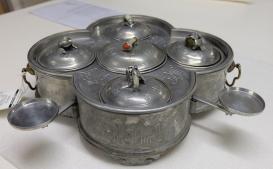This project looks at the epistemic culture of craft and statecraft from 1700 to 1844 by following the trajectory of tin as an ore from the mines to its fabrication as everyday tableware as the key ingredient in the alloy of pewter. In the Qing Dynasty, pewter craftsmen experimented with styles and techniques, and their works showed the influence of Western silver tableware, Manchu dining culture, and the interest of the literati in seal carving. The tin supply in this period came from the southwest border of China (Yunnan Province) and Southeast Asia (Bangka, present-day Indonesia). Chinese miners brought their mining technology to Bangka in the early 1700s and seized control of the nascent Bangka mining industry. The Dutch East India Company (VOC) and the British East India Company (EIC) shipped tin to China as an ideal commodity to trade for tea.
At the same time, the Qing state paid great attention to tin, as it was one of the monetary metals. The Qing state developed a system that connected the distributed knowledge of merchants, artisans, miners, and carriers. In this system, low-level bureaucrats and their assistants gained knowledge about fundraising, cost estimation, and planning in their administrative work. From the late eighteenth century, bureaucrats started to textualize this knowledge, and their writings joined the political trend of statecraft (jingshi zhiyong) in the nineteenth century.
My project analyzes the epistemic culture of craft in the context of social networks, ecology, global trade, and cultural exchange. I also discuss the epistemic culture of statecraft by looking at the skills of low-level bureaucrats, arguing that the perspective of technology and the “craft” of low-level bureaucrats can offer a new understanding of the transformation from evidential philosophy to nineteenth-century statecraft.

Pewter tableware produced in Chaozhou, trade mark “Chaoyang, Yan Huiji.” This piece was purchased by Dutch residents in Kalimantan, Indonesia, in the late nineteenth century. The seal script carved on the side shows the aesthetic preference for antiquities among contemporary consumers. Nationaal Museum van Wereldculturen, Amsterdam, The Netherlands. Similar objects can be found in Horniman Musuem in London, UK. Photo by Yijun Wang.
Project
(2017)
